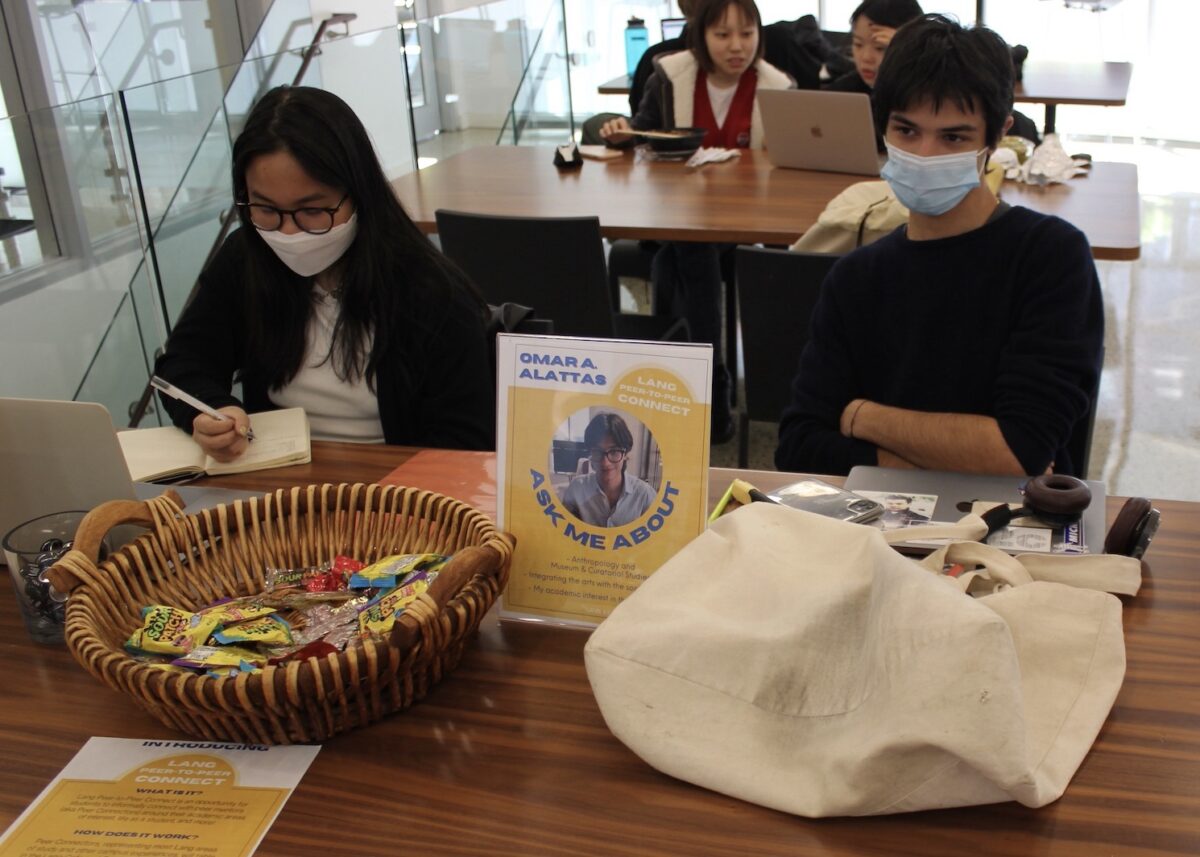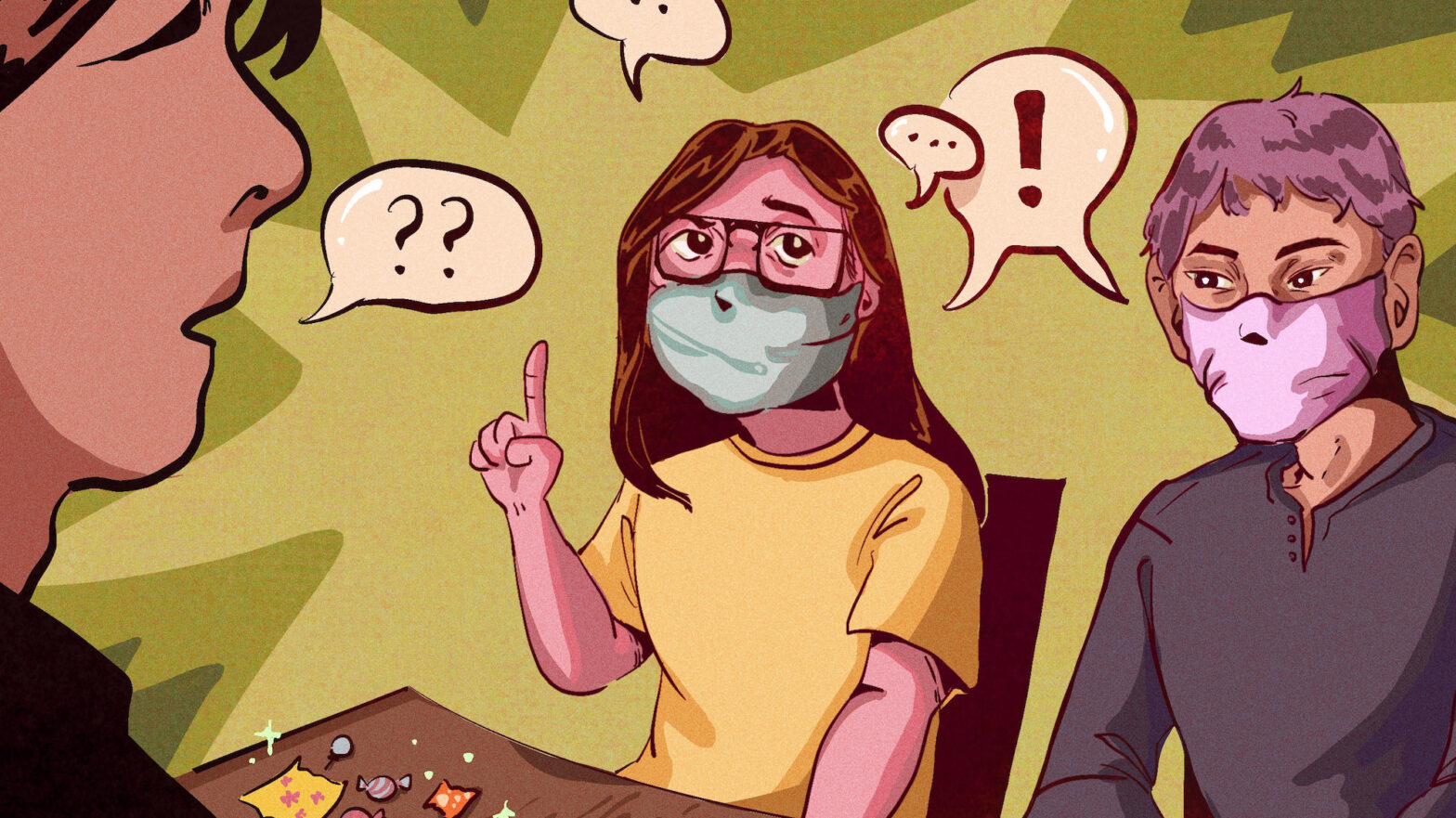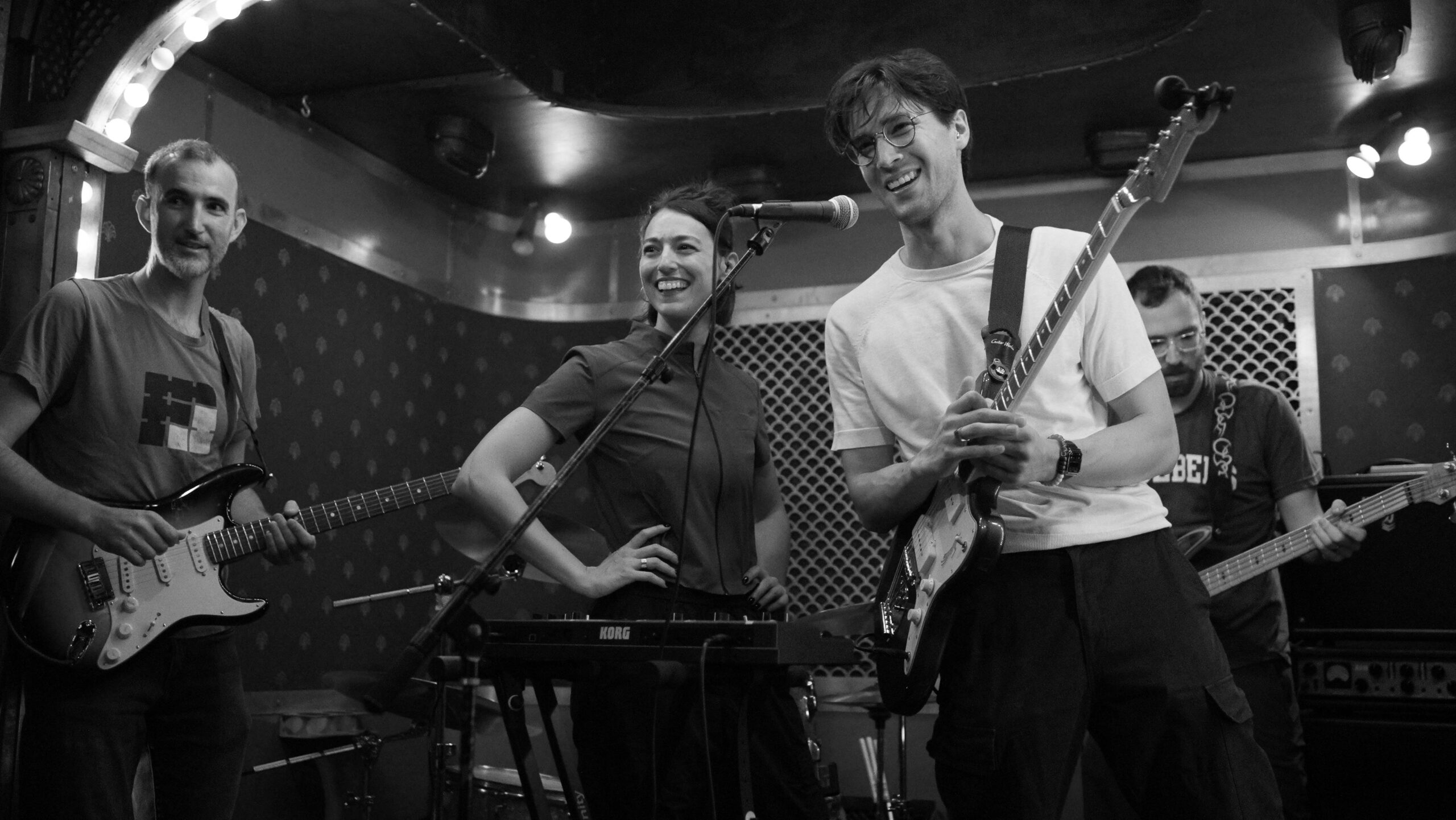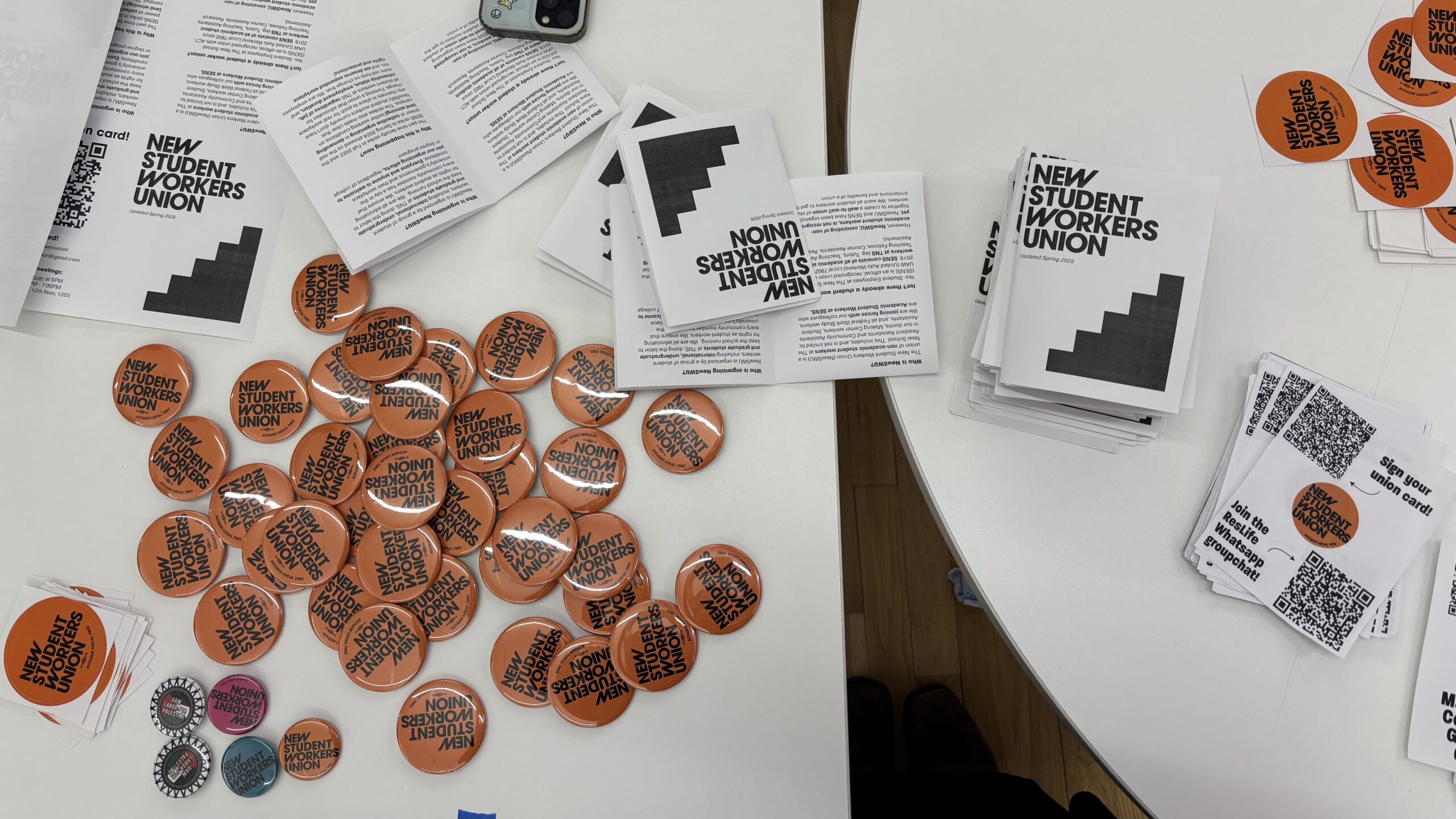Lang Peer-to-Peer Connect, a student-founded program, is running for a second time this semester after it piloted in the fall.
In the middle of the quiet Lang Cafe, two students sit at a rectangular table, passing the time completing homework and scrolling on their phones. Though the students’ faces are half covered by face masks, they can be seen in full on the informational placards sitting in front of them, which list their names and areas of study under the bold letters “Ask Me About.” As students pass through the cafe — which is functioning as everything except a cafe during the pandemic — some of them stop at the table, lured in by the bowl of candy or the chance to talk to fellow students. This is Lang Peer-to-Peer Connect, a student-founded program that piloted during the fall 2021 semester and continues to run in the spring.
The program was born out of a student’s worries regarding the fall semester. In April 2021, Alyssa Lo, then a fourth-year literary studies student at The New School’s Eugene Lang College of Liberal Arts, found herself chatting with a first-year over Zoom. Students were still going to class virtually, as they had been since March 2020 when COVID-19 hit the United States. Lo listened as the newer student shared her concerns about attending college in-person for the first time.
“When she comes to New York in the fall, she will have had an entire year at the university, but would have never been on campus,” Lo said. “There aren’t a lot of peer programs on campus, so how do you address this group of second-years who are coming physically to the school for the first time?”
Lo foresaw a challenging fall semester for Lang undergraduates. There had been university-wide staffing cuts following the pandemic, and Lo suspected there would be fewer staff in the already overstretched Student Success office, whose advisors serve Lang, Parsons School of Design and College of Performing Arts students. From personal experience, she knew community building could be difficult at Lang, and the impact of social isolation during COVID-19 lockdowns might exacerbate the issue.
Though Lo could not have known the exact conditions in which Lang would be functioning in fall 2021, she took the initiative to get ahead of a potential problem. With help from the First Year Working Group and Lang Office of Civic Engagement and Social Justice associate director Natasha Rivera, Lo spent the summer working to develop the Lang Peer-to-Peer Connect program.
The peer advising program, which ran for the first time from Oct. 20 to Dec. 2, connects specially trained, typically third- and fourth-year students with any students passing through the Lang courtyard and cafe. Most of the 16 students who served as peer connectors last semester decided to apply after hearing about the program from their professors or seeing it advertised on social media. Each student received a stipend of $250.
Lang Peer-to-Peer Connect received funding through special funds from the CESJ, which had been earmarked to deal with the impacts of the pandemic, according to Rivera.
“We [CESJ] had internally been thinking through what it would mean to develop more student programming in this transitional year and supporting Alyssa’s proposal felt like the right institutional fit,” Rivera said.
Rivera had also noticed a gap in student support that she felt the program could help fill. The two formal peer mentorship programs, First Year Fellows and Academic Fellows, were not enough, she said.
“First Year Fellows only target first-year students and Academic Fellows only target the faculty members that identified that they want an academic fellow in their class for next semester,” Rivera said. “So that leaves a huge group of students that don’t get formal and easily accessible peer interactions.”
Before starting in their roles as peer connectors, the students attended one, two-hour training session run by Lo and Rivera in which they learned about information specific to their areas of study and the various resources they could refer students to at The New School, such as the Office of Financial Aid and Student Leadership and Involvement. They also practiced having conversations with each other while using skills such as asking open questions and actively listening.
“I definitely feel like it [the training] helped a lot to refresh my memory of how to interact with people that’s not in a ‘your best friend’ type of way,” peer connector Elena Weingart, a fourth-year urban studies student at Lang, said. “Especially because of the pandemic, we forgot how to talk to people.”
The training also taught the peer connectors when it would be appropriate to elevate an issue to a member of staff, such as Rivera.
JED Campus, a project of the Jed Foundation dedicated to improving mental health on college campuses, noted the use of peer-to-peer programs within colleges in its guide to Campus Mental Health Action Planning.
“Many schools have instituted peer counseling or peer education programs to take advantage of students’ willingness to talk to their peers,” the guide states.
During scheduled time slots throughout the semester, the peer connectors would sit in pairs at a table in the Lang cafe or courtyard. The sessions were publicized beforehand on CESJ social media accounts and in newsletters to students.
“Some people just say ‘Hi’ and ‘What’s your name?’ and some people just take candy, and some people have a really long conversation,” Weingart said. “It really depends on what the person is feeling.”
According to several peer connectors, the most common topics students asked questions about were picking a major, building community and handling issues with professors.
“Everyone seemed to really enjoy just having a conversation whether it was super serious about serious issues like financial aid, issues with professors and things like that, or if it was just fun,” peer connector Arianna Guerra, a third-year studying Journalism + Design and Theatre at Lang, said.
The program doesn’t collect the names of students who chatted with the connectors, but peer connectors did fill out debrief forms at the end of each session to keep track of how they went and some peer connectors and students followed each other on Instagram after talking. If peer connectors were concerned about a student, they would put them in contact with Rivera for additional support.

“It’s been slow. I still haven’t talked to anyone,” peer connector Omar AlAttas, an anthropology student at Lang, said as he sat waiting for students during his second session in early November.
Peer connectors estimated chatting with anywhere from no students to 10 students during each hour-long session they hosted.
When the fall semester came to an end, peer connectors agreed that the program was a positive addition to Lang, and the university invited more students to apply to be peer connectors during the spring semester as the program runs again.
Building community
In pre-pandemic times, New School students struggled with feelings of isolation and lack of community support more than students at other comparable colleges. The 2019 National Survey of Student Engagement labeled this area as an issue prevalent at the university.
“For both freshmen and seniors, Supportive Environment is a challenging area — The New School ratings are lower compared with all peer groups or the gaps are more substantial in 2019,” the report states.
“Supportive Environment,” a category within “Campus Environment,” is measured by factors such as the opportunities students have to access activities, events and learning support services, and for general social involvement.
According to peer connector Michael Endrias, a fourth-year psychology student at Lang, the most common complaint students have about Lang is that it can be difficult to make friends within the college.
“You can make friends — it’s possible — but it’s also really hard to have that sense of community, or strength, when everything feels very sectioned off,” Endrias said. “There’s no real social environment at The New School.”
COVID-19 safety protocols have left the college even more devoid of human interaction this semester than before. With the exception of the first two weeks of spring term, students and faculty are almost all on campus, while most staff work remotely. Offices such as Student Health Services and Student Success remain empty; often the only way to reach a human being is via email.
The New School Provost Office just released new guidance on residence hall visitors, allowing non-residential New School students to visit the dormitories beginning Monday. For the majority of the pandemic, however, residence halls remained closed to anyone who was not currently a New School dorm resident, limiting the spaces in which students could spend time together.
“I cannot visit anyone who would want to invite me to their residence hall, and it feels like I’m just cut off,” Kartik Gupta, a first-year student at Lang who lives off campus, said in November.
The campus spaces that are open late are often empty, according to Gupta, who was sitting in the empty Lang cafe at 8:30 p.m. on a weeknight to avoid going home to his empty apartment at the time of the interview.
Guerra, a peer connector in fall 2021, connected the lack of student life on campus to the impact of the pandemic, saying that it was hard to come back to campus after over a year away.
“A lot of the students are still just in and out of the building,” Guerra said. “A lot of people don’t know that you can just hang out there [on campus] or get together with people.”
Feelings of a lack of community at The New School may have been increasing even before the pandemic. The average rating freshman undergraduates gave the quality of interactions with fellow New School students fell from 46% to 39% between 2016 and 2019, according to the 2019 NSSE.
For students like Gupta, thrown into a new college in a new city after spending months at home, Lang Peer-to-Peer Connect was a much-needed welcoming environment where they knew they could engage with other students. Gupta approached the Lang Peer-to-Peer Connect table whenever they saw it, connecting with several peer connector pairs around all sorts of topics.
“I was asking for class recommendations, which professors to stay clear from [and] which professors to stay near to,” Gupta said. “It really did act as a medium to just vent and find comfort in seniors.”
Gupta particularly connected with one of the peer connectors, and now chats for “an hour or two” every time they run into him.
The peer connectors themselves have also appreciated the opportunity to engage with other students.
“It’s definitely been something I’ve really enjoyed, especially with my busy weeks, just having an hour — it was once a week for a couple weeks there — to just sit in the Lang courtyard and just to see people that I don’t usually have the chance to see and talk to,” Guerra said.
Not only did the peer connectors occasionally exchange contact information with the students they talked to, but many of them also felt connected to their tabling partners and the peer connectors they trained alongside.
Easing strains on advising
In addition to building community, Lang Peer-to-Peer Connect also provides an additional space for students to seek academic advice.
“I was concerned with the Student Success advisors just because advising was getting slammed, especially with the layoffs last October,” Lo said.
This fall semester, many students at Lang continued to feel the impacts of staffing shortages, especially within Student Success. In response to pandemic-induced financial difficulties, The New School furloughed 250 staff members during the summer of 2020, with 68 of those furloughs being extended through the fall semester. In October 2020, an additional 122 staff were laid-off.
According to an email response Student Success gave The New School Free Press via the Marketing and Communication department, the number of students assigned to each advisor has increased in recent years, with a peak average of 345 students per advisor across all schools in fall 2021.
The NACADA: The Global Community for Academic Advising 2013 national survey lists 296 as the median number of college students per advisor in the U.S., and The New School Student Success office said it aims to have 250 students assigned to each advisor.
Some students have been frustrated by delays in email responses, while others have never felt personally connected to their advisors.
“My advisor left and I had no idea who mine was until November,” Samuel Meade, a first year fellow and second-year screen studies student at Lang, said. “I only got one email about it and did not hear from them until registration.”
For students enrolled in the BA/BFA program, turnover within advising left them without an advisor dedicated to their program for almost a year. DeShawn Ealey, who worked as the BA/BFA Dual-Degree Program advisor, left in early 2021.
On Dec. 10, Student Success announced the hiring of two new advisors, one of whom is dedicated to BA/BFA. Student Success said it is working to hire more advisors. In the meantime, they have offered group advising sessions on issues relevant to many students and enlisted the help of faculty in order to lessen the load on advisors.
Student Success advisors have worked entirely remotely since spring 2020, leaving their office space at 64 W. 11th St. empty. Students received advice via email and virtual appointments. The office plans to introduce some in-person appointments this semester, but has not announced when this will start.
Peer connector and first year fellow Siani Mesa, a third-year studying contemporary music at Lang, and Meade both said that the first-year students they mentored expressed concerns regarding their advisors.
“The lack of communication is really throwing them off,” Mesa said. “They’re having hard times with their advisors and they have to wait for emails and people aren’t as consistent with communicating.”
Both Mesa and Endrias were concerned by the divisions between different offices within Lang, including advising.
“Not having one designated area or space where you can go and visit somebody or talk to somebody about the specific things that you might need, it kind of leaves more of a ‘You’re on your own’ situation,” Mesa said.
When students reach out to their advisors, they are often referred to several other offices for help with different things, creating more stress, Endrias said.
“It just doesn’t feel like there’s a solid front there,” Endrias said.
By giving students a new set of people who they could talk to about anything and who were also on campus and visible, Lang Peer-to-Peer Connect filled a gap Student Success could not cover.
“It’s more like a direct conversation versus waiting for tons of people to respond back through emails and not getting the responses you need in time to make a decision for yourself,” Mesa said.
In some cases, the advice peer connectors provided students with may have been more relevant and honest than that of advisors due to the unique place they come from as fellow students.
“Some of the most valuable advice that I’ve gotten has been from the upperclassmen that I’ve met in my classes just with major advice, what classes to take and what professors I should take and things like that,” Guerra said.
While Endrias hopes the program will continue in the future, he does not want Lang to use it as a way to put the weight of advising on students. Rivera said that peer mentoring programs like Lang Peer-to-Peer Connect serve a different purpose than academic advisors, and that each program supplements the other.
“Advising is an amazing resource but I think there are other ways in which you get informal advice rather than be advised,” Rivera said. “It’s more of that informal conversational experiential thing that you get from your peers that is important in your decision making process as well.”
To help peer connectors serve students as peer mentors rather than formal advisors, Rivera encouraged them to always speak from their own experiences when tabling.
The future of Lang Peer-to-Peer Connect
As most of the peer connectors participate in the program again this semester, they have ideas about how it could function better.
Last semester, the tabling session schedule was planned around the schedules of the peer connectors, resulting in low turn out on particular times and days. In the future, Lo, who graduated in December, would like the schedule to be based on the schedules of first and second-year students so that more students will be able to access the service.
Endrias and Guerra would also like to see the program better advertised to the student body, as students often miss the large numbers of mass emails that flood their inboxes.
Additionally, Endrias hopes that Lang Peer-to-Peer Connect will be incorporated into specific Lang departments to increase student outreach. Rivera said this is something CESJ is already planning.
“I want this to be an intersectional program that crossects the different offices on campus,” Rivera said. “We’re thinking about how that growth is going to happen.”
With the same goal in mind, Gupta sees space for its expansion into the digital world.
“I just think it should be more active in the virtual space and in the physical space, more like people having the opportunity to just shoot a text or send an email or meet up,” Gupta said.
This could help reach students who do not feel comfortable approaching strangers in the middle of a busy college campus, as the current program requires them to do.
All students who were peer connectors during the fall and who are living in New York this semester have chosen to participate in the program again, according to Rivera. Guerra and Noor Lima Boudakian, a third-year student double majoring in global studies and economics at Lang, are serving as co-lead peer connectors this semester.
In addition to receiving an increased stipend of $375, this semester’s peer connectors will table for about 15 hours each throughout the semester, five more than those who worked in the fall.
Rivera is a proponent for student involvement, and hopes that the program will expand organically as it continues this semester and beyond.
“I really do think that’s the beauty of what it means to be a student who is involved and cares about your institution,” Rivera said. “To see it and critique it in a beautiful loving way and to offer it a solution even though students shouldn’t necessarily offer those solutions themselves.”
A version of this article appeared in the Spring 2022 International Issue of The New School Free Press. Read more stories from the print issue here.








Leave a Reply